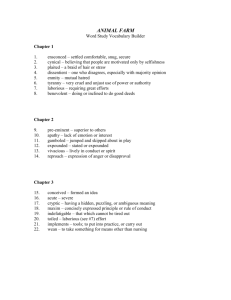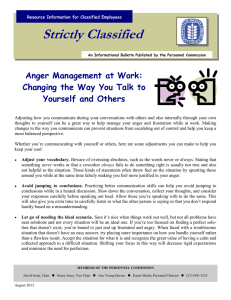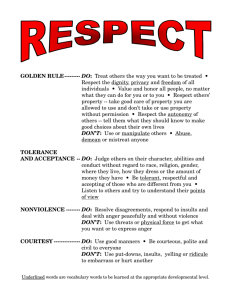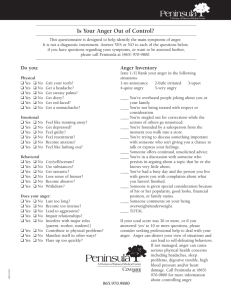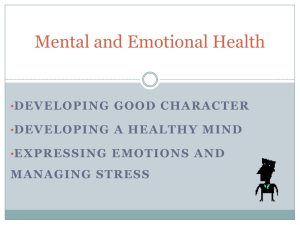Anger Management Techniques 1. Drain the Brain
advertisement
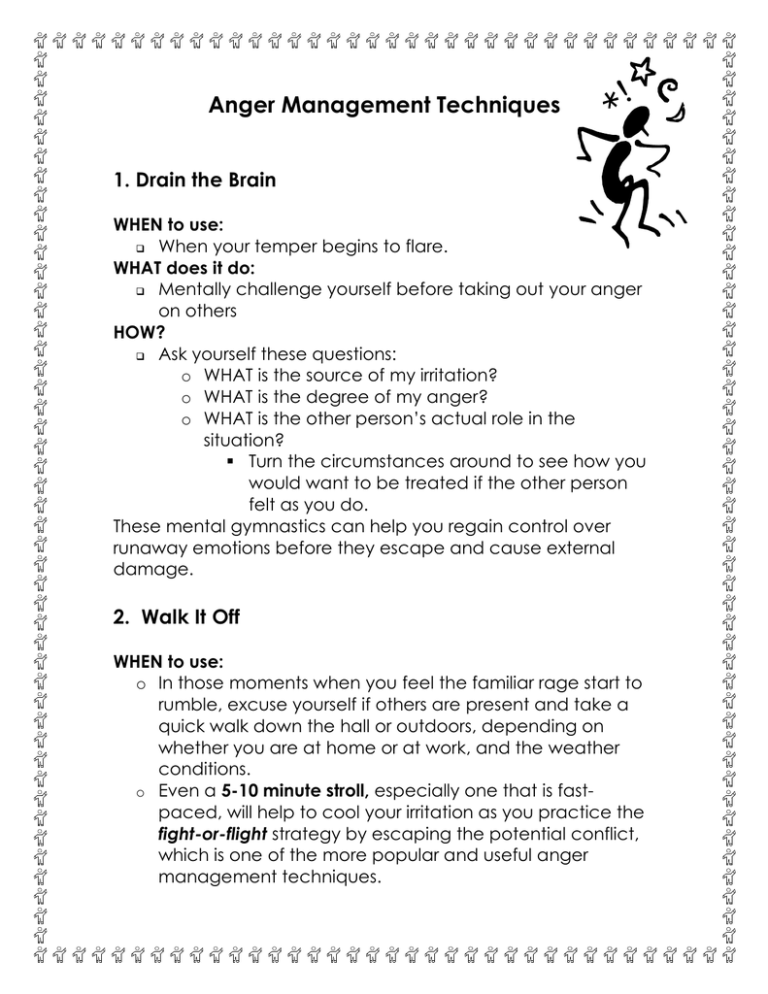
Anger Management Techniques 1. Drain the Brain WHEN to use: When your temper begins to flare. WHAT does it do: Mentally challenge yourself before taking out your anger on others HOW? Ask yourself these questions: o WHAT is the source of my irritation? o WHAT is the degree of my anger? o WHAT is the other person’s actual role in the situation? Turn the circumstances around to see how you would want to be treated if the other person felt as you do. These mental gymnastics can help you regain control over runaway emotions before they escape and cause external damage. 2. Walk It Off WHEN to use: o In those moments when you feel the familiar rage start to rumble, excuse yourself if others are present and take a quick walk down the hall or outdoors, depending on whether you are at home or at work, and the weather conditions. o Even a 5-10 minute stroll, especially one that is fastpaced, will help to cool your irritation as you practice the fight-or-flight strategy by escaping the potential conflict, which is one of the more popular and useful anger management techniques. Anger M an ageme nt Techniq ues 1.Count to 20 before saying anything. 2.Leave the room for several minutes, or hours, if necessary, before discussing sensitive issues that may provoke your anger. 3.Write out a response to a problem before tackling it orally or in debate. This will give you time to think about the best approach to a problem rather than responding with random anger. 4.Keeping a diary (journal) and writing about negative emotions to get them out of your system. 5.You may also want to keep a pet, since studies show that petting a dog or cat, for example, helps to reduce blood pressure levels and harmful substances in your system that can damage blood vessels if left unchecked. 6. Talking over situations with a trusted friend and venting to a therapist. ANGER MANAGEMENT The emotion of anger is not always a negative feeling to experience. In fact, being angry in some ways can be a positive outlet and something that should not be ignored. However, having rage inside that results in harmful tendencies towards yourself or other people, and from which the source is painful experience, is not healthy at all. This type of anger should be dealt with before it escalates into more negative experiences. Designed for your protection and safety, anger/rage is ultimately your friend and close ally. But until you can accept this kind of feeling as a part of your being, you will tend to be at war with the emotion of anger as well as yourself. You must first understand that anger is a protective emotion and then consider the ways in which anger can be useful and positive to you. Because anger or rage springs immediately from pain and fear, and then ultimately love, you must be careful that this anger is not disconnected from other basic emotions. This is when it becomes dangerous. Once you overstep that boundary of caring for your feelings or the feelings of another person, your anger has the power to instill pain, either emotional or physical. On the other hand, if you can connect love for every angry feeling you get, anger tends to dissolve and love and sense prevail. Below are four ways in which you can better understand your anger: 1. Learn to recognize the relationship that exists between the emotions of anger, rage, fear, pain, and love. There is an inherent connection between all three and the mark of a healthy individual is one where that person can target the origin from which their emotions of anger and stemming from. Is it fear? Is it pain? Or is the root cause of the anger stemming from love? 2. Learn to identify the vast differences between the actions that are motivated by fear and the actions that are motivated by love. Again, this is very similar to number one above. Your goal should be to immediately identify your feelings of anger and the feelings of anger from other people and where they come from. 3. Understand that having courage is a result of the anger-love connection. Having courage to face a problem that has resulted from being anger with a loved one is a necessity in life, but only if that courage is connected with a positive intention. 4. Begin to consider how anger shows up when it is felt and expressed in conjunction with love. Healthy couples and those that stay married for a long time have mastered this art. And it is the ability to decipher and communicate through anger when dealing with the person they are in love with. Learn to do this and you will find that you will attract more loving people into your life.
